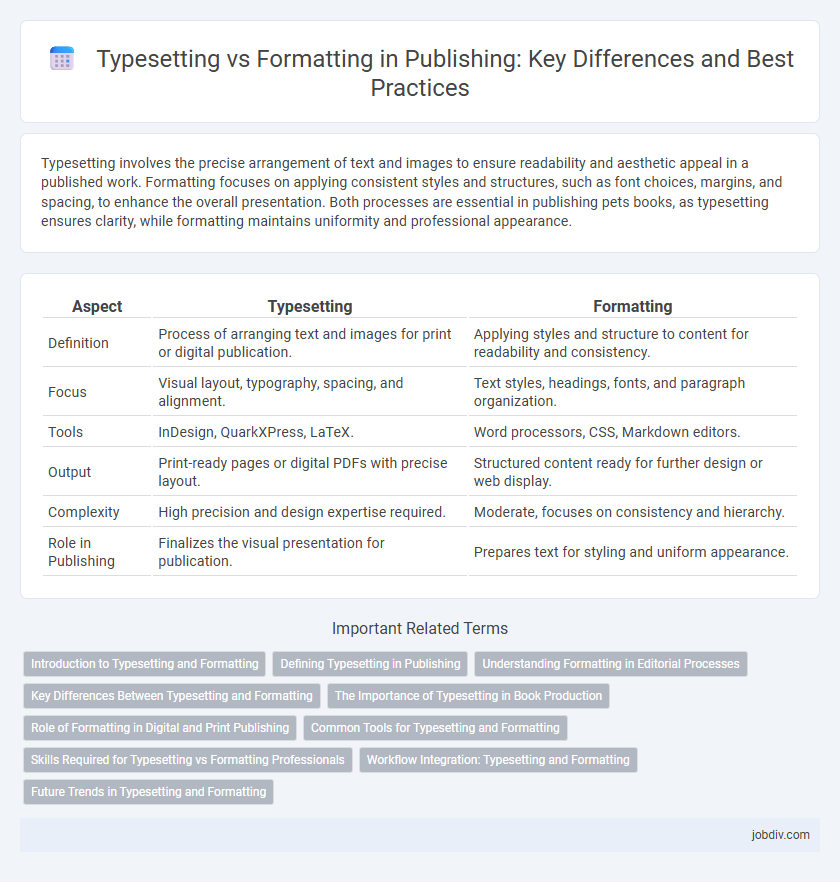Typesetting involves the precise arrangement of text and images to ensure readability and aesthetic appeal in a published work. Formatting focuses on applying consistent styles and structures, such as font choices, margins, and spacing, to enhance the overall presentation. Both processes are essential in publishing pets books, as typesetting ensures clarity, while formatting maintains uniformity and professional appearance.
Table of Comparison
| Aspect | Typesetting | Formatting |
|---|---|---|
| Definition | Process of arranging text and images for print or digital publication. | Applying styles and structure to content for readability and consistency. |
| Focus | Visual layout, typography, spacing, and alignment. | Text styles, headings, fonts, and paragraph organization. |
| Tools | InDesign, QuarkXPress, LaTeX. | Word processors, CSS, Markdown editors. |
| Output | Print-ready pages or digital PDFs with precise layout. | Structured content ready for further design or web display. |
| Complexity | High precision and design expertise required. | Moderate, focuses on consistency and hierarchy. |
| Role in Publishing | Finalizes the visual presentation for publication. | Prepares text for styling and uniform appearance. |
Introduction to Typesetting and Formatting
Typesetting involves arranging text and images on a page to ensure optimal readability and visual appeal, focusing on font selection, line spacing, and alignment for printed or digital media. Formatting, on the other hand, applies style attributes such as bold, italics, and color to enhance the document's structure and highlight key information. Both processes are crucial in publishing workflows to create professional, polished manuscripts and final layouts.
Defining Typesetting in Publishing
Typesetting in publishing involves the precise arrangement of text and characters on a page, optimizing readability and visual appeal. This process includes selecting fonts, adjusting spacing, and controlling line lengths to create a balanced and professional layout. Effective typesetting ensures that printed or digital materials maintain a consistent style and enhance the reader's experience.
Understanding Formatting in Editorial Processes
Understanding formatting in editorial processes involves organizing text and visual elements to enhance readability and maintain consistent style across publications. It includes adjusting font styles, margins, line spacing, and paragraph alignment to adhere to specific guidelines and improve the overall presentation. Effective formatting ensures a professional appearance, facilitates content navigation, and supports the publication's brand identity.
Key Differences Between Typesetting and Formatting
Typesetting involves the precise arrangement of text and characters to enhance readability and visual appeal, focusing on elements like font selection, line spacing, and alignment. Formatting refers to the broader process of structuring content, including paragraph styles, headings, and page layout, to organize information logically. Key differences lie in typesetting's emphasis on micro-level text presentation versus formatting's macro-level content organization in publishing.
The Importance of Typesetting in Book Production
Typesetting plays a crucial role in book production by ensuring text is arranged for optimal readability and aesthetic appeal, influencing the reader's experience directly. It involves precise control over font selection, line spacing, and alignment, which contributes to the overall design consistency and professionalism of the final manuscript. Proper typesetting reduces reader fatigue and enhances comprehension, making it foundational in publishing quality printed and digital books.
Role of Formatting in Digital and Print Publishing
Formatting plays a crucial role in both digital and print publishing by ensuring content is visually appealing, accessible, and consistent across various devices and platforms. It involves applying style elements such as fonts, spacing, alignment, and color schemes to improve readability and user experience. Effective formatting enhances brand identity, facilitates navigation, and adapts content to responsive layouts, making it essential for engaging and professional publication presentation.
Common Tools for Typesetting and Formatting
Common tools for typesetting include LaTeX, Adobe InDesign, and QuarkXPress, which provide precision in controlling typography, spacing, and layout essential for high-quality print and digital publications. Formatting tools often involve Microsoft Word, Google Docs, and Scrivener, offering accessible options for structuring content, applying styles, and preparing manuscripts for further refinement. Combining specialized typesetting software with versatile formatting applications ensures optimized text presentation and efficient workflow management in professional publishing.
Skills Required for Typesetting vs Formatting Professionals
Typesetting professionals require expertise in precise layout design, including mastery of typography, kerning, leading, and grid systems to ensure visually balanced text presentation. Formatting specialists focus on applying consistent styles, paragraph structures, and document templates, often using software like Microsoft Word or Adobe InDesign to standardize appearance across various platforms. Advanced knowledge of software tools, attention to detail, and understanding of publishing standards distinguish the skill sets essential for effective typesetting versus formatting.
Workflow Integration: Typesetting and Formatting
Typesetting ensures precise arrangement of text and images using software like Adobe InDesign or LaTeX, creating a professional and readable layout. Formatting involves applying style guidelines such as fonts, spacing, and headings to enhance consistency and visual appeal across the document. Integrating typesetting and formatting within the publishing workflow streamlines the production process, reduces errors, and ensures seamless transitions from manuscript to print-ready files.
Future Trends in Typesetting and Formatting
Future trends in typesetting and formatting emphasize automation and AI-driven customization to enhance efficiency and design precision in publishing workflows. Emerging technologies such as machine learning algorithms enable adaptive layouts and responsive typography that optimize readability across diverse devices and screen sizes. Integration of cloud-based collaboration tools further streamlines real-time editing and formatting processes, setting new standards in digital and print publishing.
Typesetting vs Formatting Infographic

 jobdiv.com
jobdiv.com